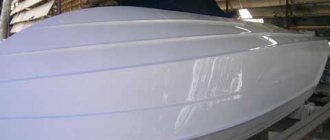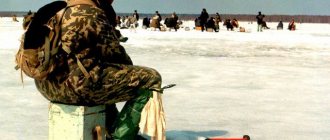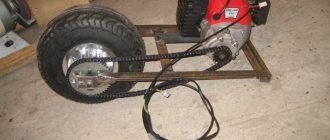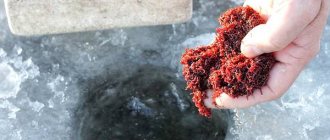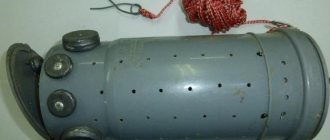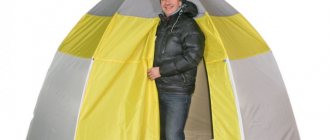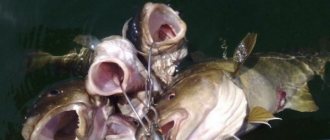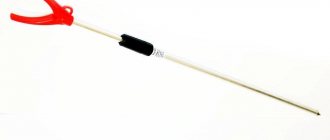Of course, there are also “correct” boats on sale, but the prices for them are so high that making them yourself is much cheaper!
Overture
Three years ago, under the influence of friends, I became interested in carp fishing.
They taught me how to catch and told me all the secrets. The first carp have arrived. And then, one day while fishing, with an envious eye I saw a fisherman with a carp boat. I really liked this ship. I asked how much it cost - I really didn’t like it ($1000 “for a minute”). The first decision was made: to make a boat for delivering bait with your own hands. I looked through the forums on RC modeling, estimated the estimate - scratched my turnip. It came out to about $150 for components. Yes, and the task seemed too easy to me (woe to me, naive one).
https://www.youtube.com/watch?v=wgsQfYQ8zac
The second decision was made: to make the most budget boat possible with your own hands, and ideally for free. Honestly, friends, not out of greed, but out of sporting interest.
So, a concept was developed: I decided to make a boat with DTMF control. This is when you call from one mobile phone (transmitter) to another (receiver), and when you press the keys, a “beep” of a different tone is heard. On the second phone (receiver), all that remains is to program the transformation of this “beeping” into different control commands depending on the received tone (one signal starts the motor, another stops it, the third turns it).
See how simple it is? I decided to convert the signal using the Arduino Uno board. We will consider this issue in detail in the Electronics section. Let's start with the body.
Radio control equipment for boats
You can take the cheapest transmitter with a receiver for 4 channels, but it will require 2 pieces of V-mix and a Y-cable.
And in the future, it will not be possible to connect anything, even such a banal thing as the backlight turned on from the transmitter.
It’s better to get a little more expensive - Turnigy 9x, 9 channels with mixing capabilities allow you to connect anything. The cost of the transmitter with receivers is 2022 rubles. Total 4170.
Frame
Initially, I planned to use the body from an old toy. The son (he had his share, so to speak) easily presented an old pirate frigate on wheels. But upon preliminary weighing of the proposed equipment (battery, motor, electronics, etc.), it turned out that the frigate did not have enough carrying capacity.
Unfortunately, I could not find a toy of a suitable shape at an adequate price in stores. And I decided to make the hull for my fishing boat myself. Again, after looking through many forums and articles, I decided that the material would be fiberglass and epoxy resin.
I started making the hull for the boat by building a blank, onto which I then planned to apply materials. I made the blank like this: I made a frame from fiberboard and cardboard. I simply attached it with hot glue to a sheet of fiberboard.
Then the compartments of the frame began to be filled with plaster (alabaster). A little life hack: add a little vinegar to the alabaster, and it will harden more slowly, but at the same time there will be intense release of gases, so do not forget to ventilate the room.
When the blank was dry, I corrected it a little and covered it with paper sketch, so that later it would be easier to separate it from the body.
The fiberglass I used is also called glass mat. The seller said that for curved shapes it is better to use it. Epoxy is the simplest.
And again a minute TB: You need to work in WELL ventilated areas. I'm not kidding. It’s not for you to mix a couple of drops in a matchbox. I bent over the hull of a fishing boat a couple of times while applying a layer of epoxy, and then for three days I couldn’t catch my breath and my head hurt.
I applied 2-3-4 layers of these. Previously, I was surprised by home-made workers: is it really impossible to count the two or three layers you applied. It turns out that while working, sometimes you have to overlap the layers, and sometimes you have to apply patches. Therefore, it is better to simply focus on the thickness of the case walls. On average, the hull walls of my fishing boat are about 3 mm thick. At this stage, the boat for delivering bait to the fishing point was called the “Pasta Monster”, because fiberglass fibers stuck out in all directions.
See about copters: Airplane, HD FPV, 600 km link via 4G / Virt2real company blog / Sudo Null IT News
Next is the most tedious task - putty. I used this universal putty with fiberglass.
And also a lot of coarse sandpaper. Then the process is clear: rub, putty, rub, putty. And so on until you understand that this is the best thing you can do with your own hands.
When I removed the body from the blank, its weight was 1 kg 200 g. Which is pretty good for such rigidity and such load capacity.
I painted it when the water cannon was already in place (described in the next section). Painting was carried out in three stages: primer and two layers of “Yacht enamel PF-167” paint.
Sled for rivers with current
A homemade unit for catching grayling in the current is also called a fishing boat. The principle of operation is the same as that of the gear described above. The only difference is that the boat, due to its special shape, has the ability to move freely against the current. This function is achieved through asymmetrical runners, a lever and other elements.
A reversible boat is made according to the same principle as a regular sled: runners are cut from non-sinking material. The runners should be different in size, as can be seen in the picture below. Connecting pins are made from equal pieces of metal. A bracket is installed on the runner that is the supporting one (smaller in size), as shown in the drawing. It is to this bow that the main line is tied so that it can move freely. On the main line, leashes are already made, to which the baits are tied directly. All. The boat is ready, you can put it on the water and fish. He will swim against the current. If you need to change the course of its movement, then just loosen the line in your hand and move it in the other direction. The loop will slide along the bow to the opposite side, and the boat will go in a different direction.
Reversible sleds are best made from lighter, more buoyant material.
Reversible ship assembly diagram
If you get puzzled and make a support float and a second runner using the same scheme, you can build an even easier-to-control model. It is equipped with a special lever. Its base is fixed with an elastic band to the body, and a fishing line is tied to the end. When the line is tensioned, the lever will rotate in the direction in which the tension occurs. If you release the line, the rubber band will return the lever to its original position, and a sharp jerk will allow the lever to turn in the other direction.
When creating a boat, you can equip a large float with an additional metal strip. It will cut through waves well when moving.
Motor. Clutch. Deadwood. Screw
In this chapter, I’ll talk about what is most intimidating in boatbuilding for beginners - about the homemade deadwood (waterproofed shaft) and what is located on both sides of it: the propeller and the motor. Well, how to connect all this with your own hands so that it works reliably and flawlessly on a bait boat.
A homemade deadwood for a boat consists of the following components:
- The body is a thin-walled tube from an old refrigerator. External diameter 5mm, internal – 4.5mm. The edges had to be rolled out manually so that bearings with an outer diameter of 6 mm would fit on both sides.
- The shaft is a stainless steel rod with a diameter of 3 mm. On one side I cut an M3 thread for attaching the propeller.
- Bearings 3*6*2 mm. I ordered the bearings from the Chinese. In the photo there were bearings with boots, but upon arrival it turned out that instead of a boot there was only some kind of wire. The Chinese returned the money, but I decided to bet what I had.
- Oil seals. Their role is played by TO-220 insulating bushings (radio components, if anything).
The photo above and the video below show how the deadwood is assembled.
During operation, the oil near the bearings can heat up and become more liquid, so I decided to add more seals from simple 3/5 mm rubber rings. They are inserted directly in front of the bearing.
I used LITOL-24 as a thick lubricant. There are several nuances in filling the deadwood. You need to fill the deadwood housing with grease so that there is only grease inside, and not half grease, half water. To do this, the tip of the syringe is cut off to create a straight tube. The piston is removed. And such a tube is simply inserted into the barrel (or whatever you have) with lubricant to the very edge. Then the piston is inserted into the syringe, and only then do we remove the syringe completely filled with lubricant without air.
As for the clutch, I consider it my duty to inform you that you need to use the factory clutch. I checked many homemade rubber and metal options, but until I bought a normal coupling and aligned the motor in a plumb line, there were constant problems with reliability and runout.
When choosing a motor, I was dumbfounded by the prices, so I started looking for alternatives. I found the most powerful of the cheap ones - this is the 540-4065 electric motor.
I think that it was even possible to use a slightly weaker motor, but I can’t say so, since I haven’t tested my bait boat with weaker motors yet. Perhaps someday it will come to this, in order to increase the power reserve from a single battery charge.
I made the propeller myself from 1 mm thick brass. I cut out three identical blades in the shape of a pig's ear. And I soldered them to a bronze stand with an M3 thread. It turned out well, but I advise you to buy it, or you will have to make a device for proportional soldering of the blades.
After the first tests, it became clear that everything works well, but under one condition: if the sternwood has a fulcrum not far from the propeller. In my case, the screw is located at a considerable distance from the deadwood exit from the body. I decided to fix it relative to the body of the water cannon by soldering three MZ nuts to the deadwood and connecting the water cannon and the deadwood with screws.
Watch about copters: How to make a radio-controlled plane with your own hands
An improved method for making a reversible boat
Fishermen who use a water kite in practice to catch fish have noticed the inconveniences associated with returning or, more correctly, catching the trophy using gear. Pulling up required some effort and constant control of the tension of the cord with instantaneous reeling, which clearly did not provide comfortable fishing. These inconveniences are especially noticeable when hunting at long distances, 100 meters or more, on rivers with moderate currents and at rapids, where the water jets are even stronger.
The inquisitive mind and ingenuity of the fisherman gave rise to the construction of reversible boats, which, with certain manipulations with the controls, change the trajectory of movement to the opposite one. Thus, bringing the cord to the shore, by influencing the direction of movement of the boat by the same water flow, but without the discomfort of winding up the cord in an emergency mode with uncontrolled fishing for the trophy. The possibility of reverse is provided by the additional placement of a metal bracket with a ring, which is attached to the outside of the small can of the swimming device. Unlike the simple method of regulating the stroke, where the thread is fastened to a stationary hook, in the reverse version the cord is knitted to a movable ring.
At the moment the boat is launched at a distance, the tension ring takes a certain position, moving the product away from the shore. If, after catching a fish or checking the bait, the cord is given slack and then sharply pulled, the position of the ring spontaneously shifts to the opposite part of the bracket. After changing the position of the fasteners, the trajectory of movement also changes, returning the vessel in the opposite direction. The bracket is the most primitive way of organizing reverse movement. Fishermen have also developed more complex mechanisms for changing trajectories, which are based on the forces of displacement of attachment points and require additional materials, tools and sketches for production, which is already within the power of experienced mechanics and mechanics.
Operating procedure
- having made the markings, cut along the red lines; - bend along thin lines and fold angles: 1 - tilt of the bow of the boat; 2 — raising the bow of the boat; 3 – lifting the stern; 4 – slope of the stern part;— fasten the bent parts with paper clips;— glue the paper with any glue, after which the shape of the boat will be ready;— measure the displacement of the boat;
2. Installation of rails for mounting the propulsion motor, antenna, gearbox, deck, electronics.
- slats for mounting the engine (1) - at the stern of the boat; - the engine is placed with a slight tilt, while a hole is drilled in the stern in order to install the propeller shaft casing, for which the syringe body will be used; in this case, the thin end of the syringe is installed outward (7);
a) two welding electrodes are ground with fine sandpaper; b) holes are drilled in the boat hulls at a distance of about 10 mm from the bow and stern; c) rods are inserted into the holes and tightened with nuts, and the joints are filled with epoxy;
- deck slats, after which a deck is cut out of a piece of plastic, holes are drilled along its contour, holes for the antenna, switches for the type of work and power supply, as well as for a tube with wires.
3. Production and installation of the propeller shaft and the propeller itself.
- the screw shaft is made of stainless steel with a diameter of 2.5 mm, it must be threaded to install the screw and polished; - a four-bladed screw is made from a piece of stainless steel with a thickness of at least 0.5 mm, then it is installed on the shaft and tightened with two keys using screws; - installed The screw at the fastening points is filled with sealant.
4. Installation of electronic equipment and decks.
Connection diagram of the left case
- the electronics are checked and configured;
- decks are installed using sealant and screws.
5. Making a transmitter (can be made from the control panel housing of an old TV or calculator):
- a connector for the antenna is made in the center of the body;
- on the side you need to install a power switch from a children's toy;
- a modulator board with a supply voltage LED is installed at the top of the case;
- a transmitter and a Krona battery are installed in the lower part of the case;
- The transmitter is connected with a wire about 15 m long to the car battery.
The boat is ready for operational testing and operation.
Varieties
This fishing tackle can be primarily classified by its bottom profile.
Catamaran/trimaran
Catamarans are good on currents and rifts, as they have higher stability. They are especially convenient in windy weather - when the fish are well saturated with oxygen and, accordingly, behave more actively and are better caught.
Flat bottom (boat)
The main advantage of a flat bottom is its high speed of movement, this applies to radio-controlled models, they cut through waves better.
Also, the feeding “boat” differs in the way it is controlled. Could be a reversible or radio controlled ship. This is if you do not take into account the ancestor of this gear in the form of a primitive sled.
Reversible ship
Reverse is a device with which you can control and change the direction of a ship's movement manually. The essence of maneuvers with a reversible “ship” is that it allows you, standing in one place on the shore, to cover more than 80% of the surface of the reservoir in the nearest access. This technique has its own name - “pendulum”.
rc ship
This model is similar to any other radio-controlled toy and is set in motion remotely thanks to a mechanism installed on it with a control panel. It usually works on the FM wave, although this is not a very convenient option, since there may be another fisherman on the shore with the same gadget, and then the signals will be confused with each other, which will lead to trouble. I'm glad that models are already being produced that eliminate background noise.
The power of the transmitting signal of such a radio-controlled remote control, as a rule, allows you to remotely control the “ship” at a distance of up to one kilometer. Radio-controlled devices operate on batteries and must include at least one spare one.
Further, complementary feeding ships can be distinguished by additional technical capabilities. These are auxiliary gadgets such as an echo sounder and a GPS navigator with autopilot.
With echo sounder
This model is easy to use, as it will immediately indicate to the fisherman where the main fish camp is located in the reservoir. Usually, when purchasing any radio-controlled bait “boat,” an echo sounder is included in the package, but this position is variable.
The display of the echo sounder indicates the distance from your location to the device, but you need to keep in mind that even the latest devices may have an error in the indicated data. For example, if a certain sector of a reservoir measuring 2 by 2 meters was chosen for fishing, then the error may be about a meter.
Among other things, the equipment with an echo sounder allows you, in principle, to explore the entire reservoir, understand the topography of its bottom, depth, and thoroughly prepare for successful fishing after analyzing all the indicators on the control panel.
With GPS navigator
Just as in the case of an echo sounder, a GPS navigator can either be installed directly on a radio-controlled model, or not, but still have the ability to install it if necessary.
The carp “boat”, also known as bait, can be used with flies. Typically sold are sets of classic flies, floating (dry) and sinking. Also, when fishing with a “boat”, various spinners and wobblers can be used.
Water jet and turning mechanism
When designing my bait boat, I simultaneously correlated the size of the propeller, water jet cylinder and turning mechanism. After searching through many options, I decided on a deodorant bottle. The outer diameter of the balloon is about 42 mm, which is 4 mm larger than the circumference of the screw, and 3 mm. less than the diameter of the rotating mechanism, which will be described below.
After 153 measurements, with trembling hands, I cut a hole in the newly completed hull of my boat.
The water cannon was glued with hot glue. I made a hole to collect water. I decided to add a piece of aluminum perforation for additional rigidity of the cylinder, since the metal in it was very thin and easily bent with little effort.
Next, I attached the motor mount to the body of the bait boat. I did it this way: I attached a screw and a rigid coupling to the deadwood. To the coupling there is a motor fixed in the mount. After that, I set the boat in such a position that the sternwood took the most vertical position, while the motor was in free suspension.
It remains to apply a little glue to fix the correct position of the fastening, and after it cools, apply the amount of glue necessary for reliable fixation.
See about copters: Radio-controlled airplanes for beginners
For the “rudder” in my fishing boat, I used a plastic jar of aquarium fish food. This jar, by the way, turned out to be divided into four parts by jumpers. All I have to do is carefully cut and mark everything for connection to the water cannon cylinder.
The turning lever is made of fiberglass 3 mm thick. I cut out an approximate shape, and then used a file and sandpaper to cut out a recess in the shape of a food can.
I took a knitting needle from an umbrella (2 mm thick) and threaded it into a waterproof boot for rods (33x12mm).
The end of the spoke was bent at an angle of 90 degrees and inserted into the SG-90 servo drive.
Electronics of a radio-controlled boat for baiting fish
To prevent water from entering the vessel, it is necessary to install a stern tube and a set of propeller, shaft and coupling.
The motors used are XK2845-B-3700KV.
The cost of a deadwood pipe is 200 rubles, the shaft with a propeller is 160, the motor costs 600 rubles. Total 960 rub. You will need 2 pieces of this in total.
You can go the other way and install Sprint F3 Tunnel Hull. The cost of one such engine assembly is 2,700 rubles, but everything is already installed in it and even a water supply has been made to the engine cooling radiator. However, for a slow-moving boat, delivering bait is not necessary.
The motors will require regulators, take the Birdie 50A Boat Regulator with 3A BEC. Cost 490 rubles. It has a water-cooling radiator and reverse speed (this is necessary for turns on water-jet propulsion).
2 regulators are also required, so another + 900 rubles and it turns out to be 1860.
To open boxes with bait you will need 1 or 2 servos. 2 – if you open each compartment independently. Yes, and it’s easier to install a servo on the compartment.
We take inexpensive servos in a dust- and moisture-proof housing, HK-15139 are perfect, they have a shaft force of 3.5 kg, the cost is 145 rubles. Total 2150.
Electrical diagram
Everyone stays where they are and no one runs away. There is nothing to be afraid of. Below is a complete wiring diagram for a fishing boat. The diagram is large because it is detailed, but now everything will become clear.
Dotted lines highlight individual blocks. You may not use some of them at all, or replace some with an inexpensive purchased analogue. Just one circuit may seem complicated to you, but you don’t even need to understand it, and if you want, you can solder even what you don’t understand.
How does a boat work when catching fish?
Such gear must be buoyant
It is important that the material for its manufacture is light and waterproof. Also, the structure needs to be given such geometric parameters so that during the current it does not turn from the specified direction.
The boat operates on the principle of a kite, only the sail is controlled by a moving boat. This way, hooks and baits will only be delivered to their destination.
The boat is effective when lowered into water with a current, also when the waves are strong. The gear drawing is simple. It is enough to know the elementary rules and basics of physics. The buoyancy of this gear is increased by making it from lightweight foam or wood.
For the fact that the boat floats, we can thank the basics of geometry, namely its corners or sides, which can create pressure on the water and push off from the shore. When you turn it 180 degrees, the move will begin in the opposite direction.
Programming Arduino microcontrollers
Arduino, if anyone doesn’t know, is a microcontroller for the general public. Very accessible and simple. Roughly speaking: I connected it to the computer via USB, loaded it with a sketch (a program that says what the microcontroller will do) and everything is ready. I will not describe the process of installing drivers and downloading programs. Everything can be found on the Arduino website.
If you have any questions, the network is full of detailed descriptions of this process.
My bait boat uses two Arduino boards: one UNO and one NANO.
For Uno, in addition to the sketch, you will need libraries.
Sled for rivers with current
A homemade unit for catching grayling in the current is also called a fishing boat. The principle of operation is the same as that of the gear described above. The only difference is that the boat, due to its special shape, has the ability to move freely against the current. This function is achieved through asymmetrical runners, a lever and other elements.
A reversible boat is made according to the same principle as a regular sled: runners are cut from non-sinking material. The runners should be different in size, as can be seen in the picture below.
It is to this bow that the main line is tied so that it can move freely. On the main line, leashes are already made, to which the baits are tied directly.
All. The boat is ready, you can put it on the water and fish.
The loop will slide along the bow to the opposite side, and the boat will go in a different direction.
If you get puzzled and make a support float and a second runner using the same scheme, you can build an even easier-to-control model. It is equipped with a special lever.
Its base is fixed with an elastic band to the body, and a fishing line is tied to the end. When the line is tensioned, the lever will rotate in the direction in which the tension occurs.
If you release the line, the rubber band will return the lever to its original position, and a sharp jerk will allow the lever to turn in the other direction.
Cover (deck) of the boat and controls on it
The material for the cover was fiberglass laminate 2 mm thick. I attached the hull of the fishing boat to a sheet of fiberglass laminate, traced the outline with a marker, and cut out the desired shape with a jigsaw.
The weight of the lid was 590 grams. For such rigidity this is quite a normal result.
Next, I placed the main power switch on the lid (it comes complete with a rubber cap),
I placed the power regulators and the toggle switch for the flashlight in a powder container, which I attached with “liquid nails” glue for complete waterproofing.
For the receiver phone and voltmeters, I used an external junction box. It also houses the battery contacts for charging the battery. On the back side there is a connector for unloading.
Comparison of homemade and store-bought boats. Characteristics and cost
It is hardly worth giving details of the models sold and their prices. It is better to give average information. The copies offered for sale have a range of 500-1000 meters and a speed of 1-3 m/s. The weight of the loaded bait is from 1.5 to 8 kg.
But the price of a boat for baiting fish with minimal characteristics is 20-30 thousand rubles. And models with a large load and range already cost over 50 thousand rubles.
As the experience of homemade designers shows, a do-it-yourself bait boat is superior in capabilities to budget purchased models. And the price is much cheaper. The cost calculations given show that you can make a homemade product by spending only 3-5 thousand rubles.
In addition, the quality of a homemade delivery vehicle is often superior to cheap purchased options.
Places of application
A fishing boat requires a certain specific reservoir where this fishing device can work effectively. If the depth of the reservoirs does not particularly affect the fishing technique, then the strength of the current, the wind speed, the size of the reservoir and the intensity of its overgrowth with aquatic plants create significant both positive and negative conditions for successful fishing.
Due to its principle of operation, the bait boat is not limited in any way by these conditions. The intensity of the thickets on the surface of the reservoir and in the horizons of its upper layers creates difficulties for fishing, interfering with the passage of the device. Bottom vegetation, reaching to the average water horizon of 1.5-2 meters, does not affect the quality of hunting and rather contributes to more successful fishing sessions using the presented set of equipment. Important circumstances for using boat fishing are fishing places under trees and bushes overhanging the water, where there is no way to deliver bait using the ordinary method of supply, spinning casting and bottom mounting.
Amazin FishBoat
New for 2022, which has not yet become a hit, but this boat has every chance of becoming a hit. Streamlined body made of ABS plastic, built-in 5200 battery, one hopper with a loading capacity of up to 2 kg. The top cover has a convenient carrying handle. The ergonomic remote control allows you to control the boat even with one hand. Three-bladed propellers and reinforced motors allow it to overtake even the famous Katran T168. One of a kind with a built-in gyro sensor for course stabilization.
Pros:
+ Automatic course stabilization (by increasing or decreasing engine power) + Large hopper, with an increased stroke angle for dumping bait at one point + Convenient remote control with joystick - allows you to control it with one hand + Easy installation of the echo sounder
Minuses:
— The battery compartment does not allow the use of a reinforced 7800 mah battery — Plastic screw protection
Useful tips
As you can see, a DIY fishing boat can be made quickly.
In addition, there are other useful recommendations that will help not only design the product yourself, but also make it durable:
- it is better to choose fiberglass rather than plywood, because it is much lighter and does not require additional protection from moisture, since it is not susceptible to its negative effects (this material is also highly durable);
- the selected battery must have sufficient capacity so that the boat does not stall in the middle of the pond, but it is also important to pay attention to the weight of the component (it should not weigh down the structure too much);
- the boat can be additionally equipped with lighting and a navigator - this will make it possible to carry out night fishing;
- In order for the product not to go under water, it is necessary to correctly calculate the displacement, which ranges from 2.5-12 liters (this is affected by the distance the ship floats, the amount of feeding, and the weight of the necessary equipment).

